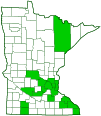Green-spored Parasol
(Chlorophyllum molybdites)
Conservation • Description • Habitat • Ecology • Distribution • Taxonomy
Conservation Status |
|||
| IUCN Red List | not listed |
||
| NatureServe | NNR - Unranked |
||
| Minnesota | not listed |
||
Description |
Green-spored Parasol. also called False Parasol, is a large, common and widespread, poisonous, gilled mushroom. It occurs worldwide in temperate and subtropical areas. In the United States it occurs from New Hampshire to Florida, west to Minnesota and California. It is most common east of the Great Plains. It is found in summer and fall in meadows, gardens, lawns, and other grassy areas. It grows on the ground, alone, scattered, or in groups but not clustered (gregarious). It often appears in large fairy rings. It obtains its nutrients from decaying organic material (saprobic). When it first appears, the cap is white and oval to almost spherical. The upper surface is dry and smooth. As it ages the cap expands and the upper surface breaks up into scales. Mature caps are broadly convex or almost flat, sometimes with a raised bump in the middle (umbonate). They can be 2″ to 15¾″ (5 to 40 cm) in diameter but are usually no more than 8½″ (22 cm) in diameter. The scales are light brown to brown or pinkish-brown, flat or curled upward at the edges, and concentrated toward the center. Between the scales the surface is white and covered with fine hair-like fibers (fibrillose). The cap does not change color when sliced. The gills are broad and closely spaced to crowded. They are not attached to the stalk (free), or are only slightly attached. They are white at first, becoming grayish to greenish as the spores mature. Between the main gills there are frequent short gills. The stalk is firm, smooth, white to brownish, 3″ to 8″ (8 to 20 cm) long, and ⅝″to 1⅛″ (1.5 to 3.0 cm) thick. It is slightly narrowed toward the top and slightly enlarged toward the bottom. It stains light grayish-brown when handled. Near the top of the stalk there is a persistent, thick, two-layered, ring of tissue, the remains of the partial veil. The ring is white at first but becomes brown and scaly at maturity. The he stalk stains reddish-brown to pale pinkish just near the base when sliced. The flesh is white, and thick in the center, becoming thin at the margins. It is firm on young caps, becoming soft in age. It is poisonous. The spore print is dull grayish-green. |
Similar Species |
Habitat and Hosts |
Meadows, gardens, lawns, and other grassy areas |
Ecology |
Season |
Summer and fall |
Toxicity |
According to an article published by the chairman of the North American Mycological Association in 2004, Green-spored Parasol is by far the most commonly consumed mushroom that is generally considered poisonous in North America. It grows in lawns and parks, it has a good flavor, and it resembles the edible mushroom Chlorophyllum rhacodes. Unwary collectors who consume one of these mushrooms can expect to quickly undergo gastric distress, vomiting, and several hours of diarrhea. |
Distribution |
||
|
Sources Biodiversity occurrence data published by: Minnesota Biodiversity Atlas (accessed through the Minnesota Biodiversity Atlas Portal, bellatlas.umn.edu, 8/24/2025). |
|
| 8/24/2025 | ||
Occurrence |
||
Common and widespread |
||
Taxonomy |
|
Kingdom |
Fungi (Fungi) |
Subkingdom |
Dikarya |
Phylum |
Basidiomycota (Basidiomycete Fungi) |
Subphylum |
Agaricomycotina (Higher Basidiomycetes) |
Class |
Agaricomycetes (Mushrooms, Bracket Fungi, Puffballs, and Allies) |
Subclass |
Agaricomycetidae |
Order |
|
Suborder |
Agaricineae |
Family |
Agaricaceae (field mushrooms and allies) |
Genus |
Chlorophyllum |
Section |
Chlorophyllum |
Subordinate Taxa |
|
|
|
Synonyms |
|
Agaricus molybdites Chlorophyllum esculentum Lepiota molybdites Leucocoprinus molybdites Macrolepiota molybdites Mastocephalus molybdites |
|
Common Names |
|
False Parasol Green Gill Green-spored Parasol Vomiter |
|
Glossary
Fibrillose
On mushrooms, covered with fine hair-like fibers.
Partial veil
A protective covering over the gills or pores of a developing mushroom. At maturity it disappears, collapses into a ring around the stem, or wears away into a cobwebby covering and ring zone.
Saprobic
A term often used for saprotrophic fungi. Referring to fungi that obtain their nutrients from decayed organic matter.
Umbonate
On mushrooms, having a distinct, raised, knob-like projection in the center of the cap.
Visitor Photos |
Share your photo of this fungus. |
||
This button not working for you? |
||
Gregory Gilman |
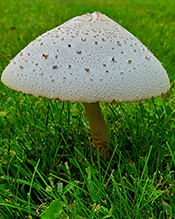 |
The fungi was 6 inches in diameter |
Jenna Walker |
||
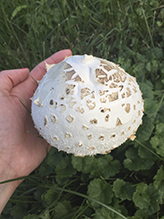 |
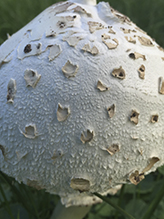 |
|
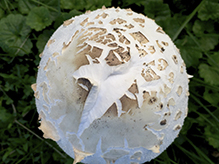 |
||
MinnesotaSeasons.com Photos |
|

Slideshows |
|

Visitor Videos |
Share your video of this fungus. |
||
This button not working for you? |
||
|
Other Videos |
Chlorophyllum molybdites |
About
Dec 31, 2015 Commonly known as the Green spored parasol,.Poisonous and often mistaken for edible varieties. Prominent along the East Coast of Australia. |
How to tell the difference between tasty parasol mushrooms and toxic green-spored parasols |
About
Jul 14, 2022 In this follow-up to my last video, I show how to tell the difference between edible and good parasol mushrooms in the Macrolepiota genus and toxic green-spored parasol mushrooms, Chlorophyllum molbydites. Although Chlorophyllum molybdites won't kill you, it's a beastly--though short-lived--experience that's best avoided. Besides substantial differences in spore and gill color between the mushrooms, these species vary in other noteworthy ways. To be blunt, I think the color, shape, and scale patterning on the cap of Chlorophyllum molybdites make them look like boobs. Macrolepiota mushrooms really do look more like parasols, lace and all. Macrolepiotas tend toward the stately and slender, with warm creamy colors and light brown scales on the cap and matching pattern on the stem. Tune in so you can tell these lovely mushrooms apart when you find them yourself! |
Green Spored Lepiota Mushroom Identification |
About
Aug 30, 2020 Green Spored Lepiota Mushroom Identification |
Poisonous Yard Mushroom: The Green-spored Parasol: Retro-Mushroom Week #4 |
About
Dec 29, 2018 A big thanks to all current and future patrons who are helping fund this science communication outreach via Patreon: http://bit.ly/2Sfmkph This is a re-release of a video I did on the mushroom channel. It seemed to help a lot of people looking at mushrooms in their yard so I hope it continues to be useful. The Green-Spored Parasol mushroom, Latin name Chlorophyllum molybdites, is responsible for many mushroom poisonings in the United States. David Arora, in his seminal work Mushrooms Demystified, claims that this mushroom causes more poisonings than any other species that grows in the U.S., and Dr. Michael Beug, a highly respected mycologist from Washington state, wrote a paper about mushroom poisoning and concluded that Green-Spored Parasols are indeed the cause of more poisonings than other North American fungi. Arora maintains this is largely because the Green-Spored Parasol is a common terrestrial species that grows abundantly in lawns, gardens, and other places where they’re tempting to people who would not normally hunt for edible fungi. Our Executive Producer for this is: Morgan Price (via Patreon) Don't forget to subscribe to this channel for more great science videos! |

|
Created: 1/25/2023 Last Updated: © MinnesotaSeasons.com. All rights reserved. |
